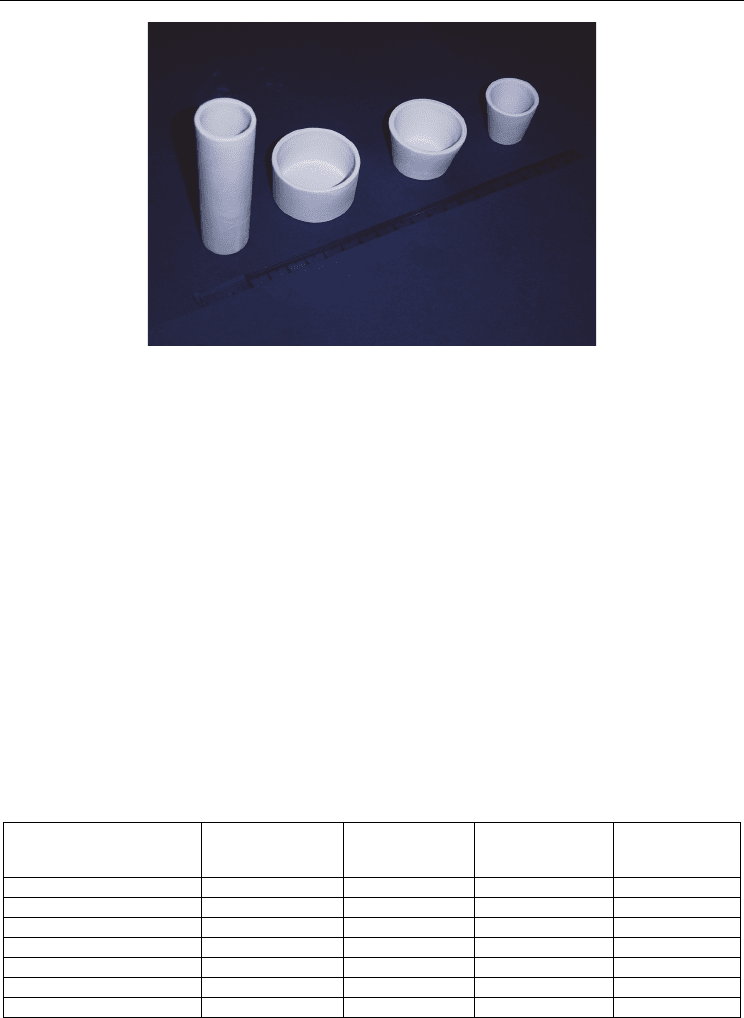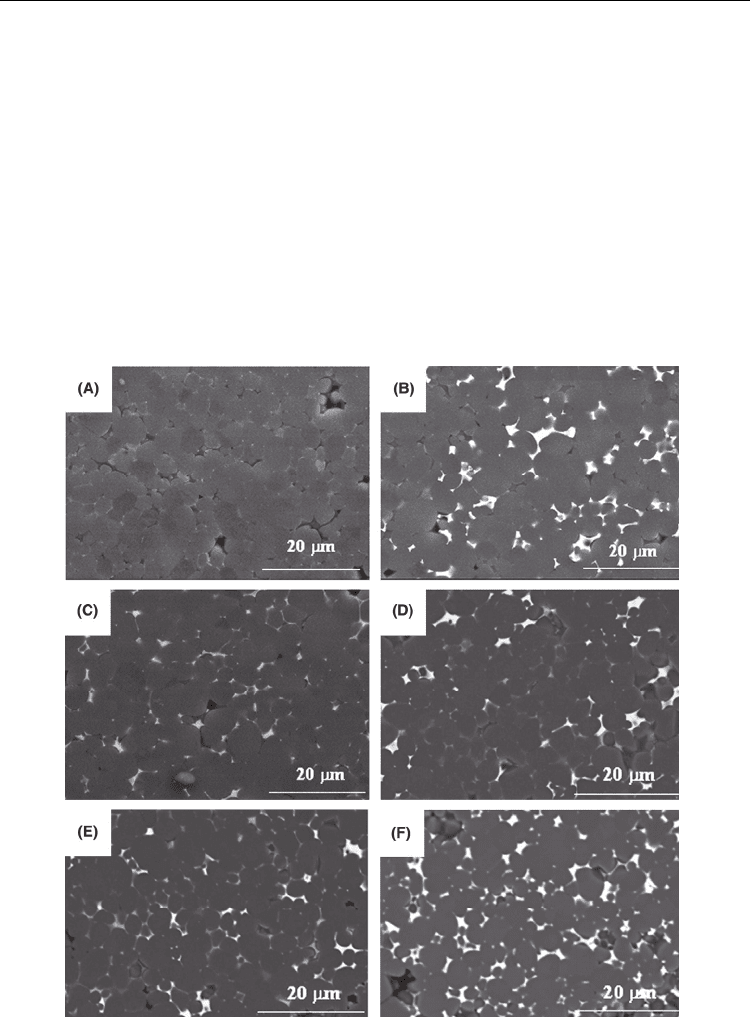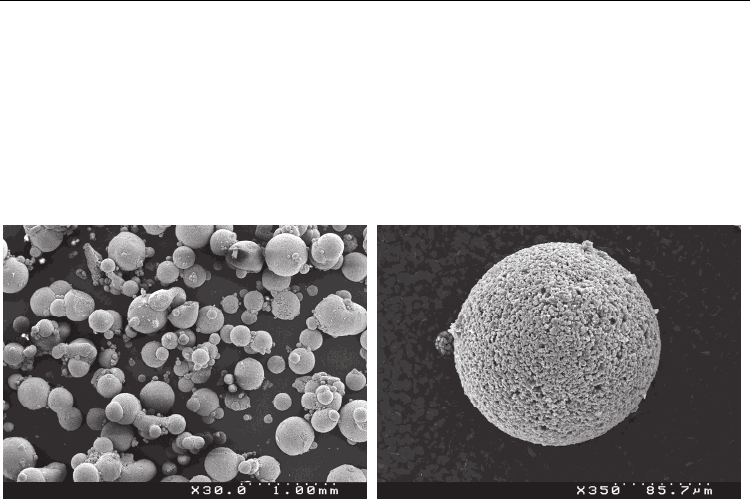Sikalidis C. (ed.) Advances in Ceramics - Synthesis and Characterization, Processing and Specific Applications
Подождите немного. Документ загружается.


Last Advances in Aqueous Processing of Aluminium Nitride (AlN) - A Review
219
Fig. 9. AlN crucibles obtained by slip casting with an aqueous suspension containing 50-
vol.% solids.
3.1 Densification studies of slip casted AlN samples
The quality of ceramic processing based on powder technology, including many steps from
preparation of raw materials to sintering of shaped components is a key point. Each step is,
in different ways, crucial for the ultimate material properties. The quality of the starting
powders, particle size, particle size distribution and particle shape are crucial factors which
in an integrated way influence the final material properties (Komeya et al., 1969).
Using the green slip casted samples obtained above with aqueous treated AlN suspensions
with 50-vol.% solids, full dense aluminium nitride (AlN) ceramics were obtained after
sintering for 2 h at 1750ºC and characterised for Vickers hardness (1000 Hv), flexural
strength (200 MPa), and thermal conductivity (115 W/mK) (Olhero et al., 2006a). YF
3
and
CaF
2
were used as sintering additives in total amounts ranging from 5 to 7-wt.%, in ratios of
1.25; 1.5 and 2. The sintering additive compositions seem to affect the mechanical properties,
density and thermal conductivity through the amount of intergranular phases formed, the
volume fraction of porosity, the grain size and grain size distribution, as Table 3 and Fig. 10
suggest. The codes, A, B, C, D, E and F refers the different amounts of sintering aids used as
follows: A- 5-wt% CaF
2
; B- 3-wt.% YF
3
; C- 2-wt.% YF
3
+ 1-wt.% CaF
2
; D- 3-wt.% YF
3
+ 3-
wt.% CaF
2
; E- 4-wt.% YF
3
+ 2-wt.% CaF
2
and F- 4-wt.% YF
3
+ 3-wt.% CaF
2
.
Samples
Sintered density
(%TD)
Thermal
conductivity
W
m
-1
K
-1
Hardness
(Vickers)
Mechanical
Strength
(MPa)
A
99.01± 0.74 93.7 ± 4.68 962.3 ± 28.16 128.5 ± 15.9
B 99.6 ± 0.76 75.0 ± 3.75 1062.1 ± 64.03 135.5 ± 14.0
C 99.8 ± 0.56 77.9 ± 3.89 1100.1 ± 51.37 157.5 ± 20.9
D 100.1 ± 0.08 113.0 ± 5.65 971.3 ± 38.90 178.7 ± 22.8
E
99.9 ± 0.21 115.0 ± 5.75 950.2 ± 27.30 218.8 ± 18.7
F 99.5 ± 0.18 108.0 ± 5.40 908.9 ± 47.18 203.1 ± 21.3
W
ithout additives 99.01± 0.74 93.7 ± 4.68 962.3 ± 28.16 128.5 ± 15.9
Table 3. Final properties (sintered density, thermal conductivity, hardness, and flexural
strength) of the AIN samples.

Advances in Ceramics - Synthesis and Characterization, Processing and Specific Applications
220
Except the pure AlN samples that presented a relatively low sintered density (80%) and the
sample with added 5-wt.% CaF
2
(composition A, 97%), all the other compositions exhibit
high densification levels (>99.5%TD), which tend to increase with an increase in the total
amount of sintering additives. Nearly fully dense materials were obtained for compositions
with higher total amounts of sintering aids (D and E). However, compositions B and C with
the lowest total amount of sintering additives (3-wt.%) are denser (>99.5% TD) than
composition A (99% TD) with 5-wt.%, the same total amount as in the fully dense
composition D (100% TD). For composition F with the highest amount of sintering additives,
the sintering density decreased (99.5 wt% TD), probably caused by an excess of secondary
phases. In the system CaF
2
–YF
3
, the latter component is clearly the most effective one.
Incomplete densification might be caused by the incomplete oxygen consumption at the
grain boundaries and an insufficient amount of liquid phase formed. The increasing amount
of intergranular phases and the concomitant increase in sintered density enhanced the
flexural strength of the AlN. This is according to the microstructural observations on
fracture surfaces (Figure 10) that clearly showed a number of transgranularly fractured
Fig. 10. Backscattering images of the polished AlN samples (A, B, C, D, E, and F) after
sintering at 1750°C for 2 h.

Last Advances in Aqueous Processing of Aluminium Nitride (AlN) - A Review
221
grains, indicating strong bonding and high strength of the intergranular phase. The increase
in the amount of sintering additives resulted in a decrease of microhardness due to the
lower hardness of the secondary phases between AlN grains in comparison to that of
crystalline AlN grains (Olhero et al., 2006a).
Therefore, the amount and ratio of the sintering additives play important roles in the
microstructural development and in determining the final physical properties of the
sintered bodies. These results were explained afterwards, as it will be shown in the next
sections.
4. Application of the AlN aqueous suspensions in other colloidal processing
techniques
From the technological point-of-view, the inhibition of hydrolysis at the AlN particles
surface, a good dispersion of the protected powders and the control of the rheological
behaviour of highly concentrated AlN-based suspensions, are the key factors to extend the
application of aqueous AlN suspensions to other fields of ceramic processing. Examples
include the use of other colloidal shaping techniques such as tape tasting, gel casting and so
on, or the production of granulated powders (freeze granulation) for the dry pressing
technologies. As stated above, from the rheological point-of-view, a shear thinning
behaviour is desirable for the highly concentrated aqueous suspensions of the protected
AlN powder, especially if the suspensions have to undergo relatively high shear rates in a
given processing step. Such requirements are therefore of major importance in the particular
cases of tape casting or freeze granulation due to the high shear rates achieved when the
suspension passes under the blade or through the spray nozzle. The compatibility between
dispersants, binders and plasticizers and their specific interactions with the AlN protected-
surface and water must be also taken into account, since they affect the sintering density and
the final properties of the AlN-based ceramics, such as the required excellent thermal
conductivity.
4.1 Freeze granulation
Granulation is a size enlargement operation by which a fine powder is agglomerated into
larger granules to generate a specific size and shape to improve flowability and appearance
and, in general produce a powder with specific properties such as granule strength,
apparent bulk density and compacting ability. Compared to the conventional powder
granulation technique by spray drying, freeze granulation has the advantage of obtaining
granules without inner cavities and with a higher degree of homogeneity, due to the
absence of binder segregation during drying or the migration small particles (Nyberg et al.,
1993; Nyberg et al., 1994). The density and other physical properties of the freeze dried
granules can be controlled by varying the solids content of the slip, the particle size
distribution and a proper combination of processing additives to confer the suspension the
desired shear thinning behaviour and avoiding pumping difficulties and/or clogging of the
spray nozzle that divides the suspension into small droplets. The presence of the binder and
plasticizer is essential for confer to the forming granules the required physical properties
and the compacting ability, therefore eliminating the possibility of using suspensions
without processing additives. Fig. 11 shows general microstructural aspects as well as
details of the granules obtained after spraying and freezing suspensions with 50-vol.%
solids containing 5-wt.% binder + 2.5-wt.% plasticizer (P200). The high homogeneity of the

Advances in Ceramics - Synthesis and Characterization, Processing and Specific Applications
222
binder and plasticizer in the starting suspensions was determinant for the reproducibility of
granules characteristics after spraying and freezing, namely: (i) granules size (100-800 m),
(ii) wide granule size distribution, and (iii) perfectly round shaped and smooth granule
surface. Varying the amounts of binder and plasticizer the aspect of the granules is similar
although higher binder amounts affect the compacting ability of the granules in dry
pressing. In fact, the increased plasticity of the granules containing the highest content on
the polymeric additives binder and plasticizes would account for the higher density values
in the greens obtained after uniaxial pressing.
Fig. 11. Size, size distribution and microstructure of the granules obtained by freeze
granulation from AlN aqueous suspensions containing 50-vol.% solids and 3-wt% binder +
1.5-wt% plasticizer (P200).
4.2 Tape casting
Oppositely to freeze granulation, tape casting process using AlN suspensions in aqueous
media was already reported by other authors (Chartier et al., 1992; Hotza & Greil, 1995; Xiao
et al., 2004). As in other forming methods, the arrangement and packing of the AlN particles
in the green body influences the sintering behaviour and the final properties. The green
microstructure depends on the system to be consolidated and the forming technique
employed. Assuming well-dispersed starting slurry, the microstructure of the casting tapes
will be determined by two key processing factors: (i) particles’ arrangement during the
casting process and the shrinkage during drying; (ii) the shear stress generated when the
slurry passes under the blade. Due to all of these reasons, the rheological behaviour of the
suspensions is of paramount importance in the tape casting process. The rheology
determines the flow behaviour in the casting unit, which is dependent on the type and
concentration of powder, binder, solvent and other organic additives such as dispersants
and wetting agents. In order to obtain aqueous AlN-based suspensions with suitable
viscosity for tape casting, and tapes with good mechanical properties (strength and
flexibility) the same processing additives used for freeze granulation were also added but in
larger amounts: 10- and 15-wt.% of binder and 5- and 10-wt.% of P200 (Streicher et al.,
1990a). In same formulations the plasticizer P200 was replaced by a higher molecular weight
one, P400, added in the same proportions. All the viscosity curves presented a first shear
thinning that is a desired behaviour for the tape casting process, enabling structural

Last Advances in Aqueous Processing of Aluminium Nitride (AlN) - A Review
223
decomposition when the suspension passes under the blade and its level out, as well as, the
structural regeneration after passing the blade, avoiding particles segregation and unwanted
post-casting flows. Therefore, it is important to mention that no evident incompatibility
between binder and plasticizers was observed. From all the suspensions tested, it was
possible to obtain un-cracked green tapes, presenting smooth and uniform surfaces, as those
shown in Figure 12 (Olhero & Ferreira, 2005). The minimum amount of binder required to
produce flexible tapes with a thickness value as high as 1.5 mm was seen to be 15-wt.%.
Thicker tapes could be obtained by increasing the solids loading in suspensions through
partial evaporation of the excessive water introduced with the emulsion binder.
Fig. 12. Green tapes obtained by tape casting from the aqueous AlN-based suspensions.
5. Influence of de-waxing atmosphere on the AlN properties
High-performance advanced electronic packaging for high-density circuits and high-power
transistors needs to have high thermal conductivity to dissipate the heat generated during
functioning in order to have lower operational temperatures and improved reliability and
performance. In the last 10 years, AlN ceramics have been intensively studied for substrates
applications due to the high thermal conductivity, non-toxicity and low dielectric constant
among other properties (Collange et al., 1997; Enloe et al., 1991; Jackson et al., 1997; Raether
et al., 2001). The thermal conductivity was found to depend on several factors, namely
intrinsic and extrinsic. The intrinsic ones are material dependent such us the oxygen content
(total and lattice dissolved), the microstructure, lattice defects among others, while the
extrinsic ones are sintering conditions (atmosphere, furnace), sintering temperature, time
and sintering additives. Hence, to achieve excellent properties of AlN, namely high thermal
conductivity, it is important to know how to optimize the extrinsic factors, which in turn
influence the intrinsic ones. One factor that promotes deleterious sintering is the presence of
oxygen at the grain boundaries. In fact, along the sintering period, impurities such as
oxygen are solid-dissolved in AlN crystal lattices or form a composite oxide, such as Al-ON,
which hinders the propagation of the thermal oscillations of the lattice. During firing, these
impurities are incorporated into the AlN lattice by substitutional solution in the nitrogen
site, creating aluminium vacancies, according to the following reaction (5):
Al
2
O
3
→ 2Al
Al
+[·]
Al
+3O
N
(5)

Advances in Ceramics - Synthesis and Characterization, Processing and Specific Applications
224
where [·]Al denotes an aluminium vacancy.
Mass and strain misfits caused by the vacant aluminium site increase the scattering cross
section of phonons, which decreases the phonon mean free path, thereby lowering the
thermal conductivity. Taking into account the reasons exposed above, numerous efforts
have been done aimed at lowering the oxygen content within the AlN grains and grain
boundaries to decrease the temperature of densification and consequently to reduce the
costs of the AlN substrates (Jarrige et al., 1993; Liu et al., 1999; Qiao et al., 2003b; Streicher et
al., 1990b; Thomas et al., 1989). The use of sintering aids has been the approach more
extensively studied to enhance AlN densification and thermal conductivity (Baranda et al.,
1994; Boey et al., 2001; Buhr & Mueller, 1993; Hundere & Einarsrud, 1996; Hundere &
Einarsrud, 1997; khan & Labbe, 1997; Qiao et al., 2003a; Qiao et al., 2003b; Virkar et al., 1989;
Watari et al., 1999; Yu et al., 2002). If oxygen impurities in raw powders react with sintering
aids to form stable alumina compounds at the grain boundaries of sintered AlN, oxygen
impurities do not diffuse into AlN lattice and crystal defects are not produced (Hyoun-Ee &
Moorhead, 1994). The thermodynamics and kinetics of oxygen removal by the sintering aids
determine both the microstructure and the impurity level of AlN ceramics. Therefore,
besides adequate selection of sintering aids, suitable sintering conditions are very important
to prevent further increase in the oxygen content of the AlN powder (Lavrenko & Alexeev,
1983; Wang et al., 2003). A higher thermal conductivity is achieved if the grain boundaries
are clean from sintering additives and the system is free of oxygen. This is accomplished by
heat treatments that lead to liquid removal by evaporation or migration to concentrate at
grain-boundary triple points. Recently, Lin (Lin et al., 2008) studied the effect of reduction
atmosphere and the addition of nano carbon powder to enhance deoxidation of AlN parts.
The viability of using aqueous media for processing AlN at industrial level is strongly
dependent on the final properties, namely thermal conductivity and mechanical properties.
The achievement of comparable properties using water to disperse the powders (AlN +
sintering aids) and aqueous suspensions to consolidate green bodies by colloidal shaping
techniques or to granulate powders for dry pressing, will have enormous benefits in terms
of health, economical and environmental impacts. Further benefits will be obtained if the
AlN ceramics processed from aqueous suspensions can be sintered at lower temperatures
than those usually used (>1850ºC) to densify AlN ceramics processed in organic media
without jeopardizing the final properties (high thermal conductivity, mechanical strength,
etc.). As exposed above, aqueous processing of AlN needs a surface protection of the
particles to avoid hydrolysis, turning the system more complex. Therefore, transposing the
findings of sintering studies using AlN samples prepared in organic media to sam
ples
processed in aqueous media is not straightforward. The coating layer composed of oxygen
and phosphorous might turn the sintering behaviour ambiguous, and further studies were
necessary. In fact, the surface layer used to protect the AlN particles could be a trouble for
the sintering process, due to the rising amount of oxygen content at the surface of AlN
particles supplied by the protection layer (Olhero et al., 2004). Moreover, when binders and
plasticizers are used as processing additives, such as in tape casting or powder granulation,
it is necessary to remove these organic species prior to densification. Due to the easy
oxidation of aluminium nitride in presence of oxygen and the residual carbon supplied by
the organic species during burnout, the de-waxing atmosphere is a critical parameter
(Olhero et al., 2006b).

Last Advances in Aqueous Processing of Aluminium Nitride (AlN) - A Review
225
Table 4 presents the amounts of carbon, oxygen, phosphorous, aluminium and nitrogen
measured for the different AlN powders, without treatment (AlN), after thermochemical
treatment (AlN-T), and for the samples A, B and C after de-waxing under different
atmospheres (air or N
2
). A, B, and C are samples that presents different amounts of sintering
aids and binders as follows: A: 3-wt.% YF
3
+ 2-wt.% CaF
2
and 4.5-wt.% organic binders; B: 4-
wt.% YF
3
+ 2-wt.% CaF
2
and 4.5-wt.% organic binders; C: 4-wt.% YF
3
+ 3-wt.% CaF
2
and 4.5-
wt.% organic binders. The ratios between the different elements, O/Al, N/Al and C/Al are
also shown. Comparing the results for AlN and AlN-T powders, it is clear that there was an
important surface enrichment in oxygen (≈9–10 wt.%) and P (≈8 wt.%) elements attributed
to the phosphate species of the protective layer against hydrolysis, and a concomitant
depletion of N and Al elements, confirming the results of the earlier report (Olhero et al.,
2004). The decrease of the amount of aluminium at the surface of the AlN-T might also be
partially due to a possible reaction between the oxygen and the aluminium to form
aluminium oxide and oxynitride (Bellosi et al., 1993; Ichinose, 1995; Osborne & Norton,
1998).
Elements
Content (at %)
AlN AlN-T
Sample A Sample B Sample C
O
2
N
2
O
2
N
2
O
2
N
2
C (1s)
12.61 12.91 13.79 20.96 12.81 21.63 13.96 21.68
N (1s)
16.99 9.35 6.05 6.21 6.19 6.54 6.14 6.38
O (1s)
35.75 44.97 45.86 40.84 45.91 40.84 45.98 40.68
Al (2p)
34.65 24.97 26.06 23.79 26.52 23.44 25.73 23.08
P (2p)
--- 7.80 8.24 8.20 8.58 7.55 8.18 8.19
Table 4. Comparison of surface composition measured by XPS of the AlN powder without
treatment and AlN treated powder (AlN-T) before and after de-waxing under different
atmospheres (air or nitrogen).
Comparing the results for AlN-T and the compositions A, B and C after de-waxing in air
atmosphere, it can be concluded that the surface of AlN particles becomes about 1-wt.% rich
in oxygen after the burnout step. On the other hand, de-waxing in N
2
atmosphere results in
significant decrease of the amount of oxygen (≈4 wt.%) and a concomitant increase in the
carbon content (≈8–9 wt.%). The analysis of the atomic ratios between the different elements
reveals that O/Al ranges from 1.73 to 1.79 for the samples de-waxed in air, and between 1.72
and 1.76 for the specimens de-waxed in N
2
. On the other hand, the N/Al is 0.23–0.24 for the
first set and 0.26–0.28 for the latter one. However, differences in the C/Al atomic ratio are
the largest: 0.48–0.54 in air, and 0.88–0.94 in N
2
. These results are in good agreement with
the findings of other authors (Nakamatsu et al., 1999; Yan et al., 1993). Therefore, the binder
burnout process left a significant amount of residual carbon on the AlN surface, which is
larger in the case of the samples heat treated in nitrogen. By analysing the C1s peak, Yan
(Yan et al., 1993) concluded that the first layer of carbon is bound to oxygen atoms at the
AlN surface while additional carbon is bound to carbon itself, forming amorphous
graphitoid carbon clusters which covered the powder surface uniformly. In spite of carbon
increasing after binder burnout, oxygen content seems to be the most abundant element at

Advances in Ceramics - Synthesis and Characterization, Processing and Specific Applications
226
the surface of all AlN powders. Therefore, the use of proper amounts of sintering aids is of
crucial importance to help releasing the excess of oxygen. Recently, Robinson and co-
workers found that oxygen distribution was not continuous along thickness direction of the
oxidized AlN (Robinson & Dieckmann, 1994; Robinson et al., 1994). They suggested that
additives enhancing densification may be critically important to the oxidation kinetics of
AlN polycrystals and the oxidized structure as well. Wenjea Tseng (Wenjea et al., 2004) also
supported this proposition by showing that the additive chemistry and the doping level
both play crucial roles in determining the oxidation behaviour of fully sintered AlN. Using
different amounts and proportions of sintering additives did not affect the surface chemistry
of AlN particles after de-waxing, but influenced the thermal properties after sintering.
The results of density and thermal conductivity of the different AlN-based compositions
after de-waxing (in air or nitrogen) and sintering at 1750ºC for 2 h are reported in Table 5.
Considering that the standard deviation of sintered density is ±0.1%, one can conclude that
full densification was obtained for all the compositions tested, independently of the de-
waxing atmosphere used. The values of thermal conductivity are also reported in Table 5,
with a standard deviation of ±5%. Since all samples reached full density, the observed
differences in thermal conductivity cannot be attributed to the densification degree. The
nature and concentration of sintering aids and the de-waxing atmosphere are the most
relevant factors determining thermal conductivity, which in turn depends on the
microstructural features and on the crystalline phases formed. Significant differences
(increases of 22%) in thermal conductivity are observed when comparing the data of
samples sintered in air and in nitrogen. These differences might be related to the secondary
intergranular crystalline phases. Yttrium aluminium monoclinic (YAM-Y
4
Al
2
O
9
) is present
when nitrogen atmosphere was used, while yttrium aluminium perovskite (YAP-YAlO
3
) or
YCaAl
3
O
7
were formed when de-waxing was made in air.
Sintered densities
(%TD)
Thermal conductivity
(W/m.K)
Samples
De-waxing in
air (O
2
)
De-waxing
in N
2
De-waxing in
air (O
2
)
De-waxing
in N
2
A
100 100 111 125
B
100 100 111 136
C
99.8 99.9 119 136
Table 5. Density and thermal conductivity values of the sintered AlN samples
The origin of these secondary crystalline phases in the sintered samples is postulated to be
as follows. The surface of AlN treated powder contains significant amounts of oxygen and
phosphorous coming from the protective layer against hydrolysis. XPS analysis revealed
that the phosphorous element still present at the surface of AlN powders after de-waxing at
500ºC (Table 4) could no more be detected after heat treating the samples at temperatures
≥1400ºC (temperature of liquids). This means that P element volatilizes upon heating up to
1400ºC. The formation of liquid phase is expected to occur at ≈1400ºC, according to the
phase diagram (Roth et al., 1983). The oxygen remaining at particles’ surface reacts with the
sintering additives (YF
3
and CaF
2
) to form a low melting point eutectic phase. This liquid
phase assists the densification process and gives rise to crystalline phases, such as YAM or

Last Advances in Aqueous Processing of Aluminium Nitride (AlN) - A Review
227
YAP, either precipitated during sintering or on solidification. It is worthwhile to note that
the yttrium-richer second phases were formed when the de-waxing was made in nitrogen
atmosphere. Therefore, a correlation between the C/O atomic ratio at the AlN powder
surface and the Al/Y/Ca in the second phase of the sintered material can be found. In fact,
secondary intergranular phases became yttrium-richer (Y
4
Al
2
O
9
) as surface C/O ratio
increases, consequently enhancing the thermal conductivity. The change of the secondary
intergranular phases from aluminium-rich to yttrium-rich can be understood based on
carbon de-oxidation during sintering, which removes oxygen impurities from the grain
boundaries according to the following chemical reaction:
Al
2
O
3
+3C + N
2
→ 2 AlN + 3CO (6)
The above results are in good agreement with those reported by other authors who
defended that when Y
4
Al
2
O
9
is formed in AlN-Y
2
O
3
ceramics instead of Y
3
Al
5
O
12
or YAlO
3
,
the highest thermal conductivity can be achieved (Nakano et al., 2003; Virkar et al., 1989).
The distribution of the secondary phases in the samples, which may contribute to the
increase in thermal conductivity, was also found to be dependent on C/O ratio (Yan et al.,
1993). The effect of de-waxing atmosphere on microstructural features of fracture surfaces of
sintered samples A and C can be observed in Figure 13 and Fig. 14, for the samples de-
waxed in air and nitrogen, respectively. It can be seen that AlN grains are separated by
grain-boundary films, the thickness of which depend on the type of de-waxing atmosphere.
The results of EDS analysis of the inter-granular films revealed that they consist of different
proportions of Y, O, Al and N, being more yttrium-rich when de-waxing was in N
2
. In
samples A and C de-waxed in air, the inter-granular films extend along the whole grain
boundaries showing good wetting properties. The presence of these grain boundaries films
disrupts the connections between grains and consequently decreases the thermal
conductivity. Contrarily, the inter-granular film in sample A and C de-waxed in N
2
atmosphere is thinner and the secondary phases are apparently less abundant and appear
preferentially located at the triple points. These differences can be related to the surface
composition of the AlN grains. The higher C/Al atomic ratios (see Table 4) of the samples
sintered in N
2
atmosphere will decrease the ratio between the grain-boundary energy (γss)
and the solid–liquid interfacial energy (γsl), γss/γsl, leading to the isolated structure of the
second phase observed in these specimens and increasing the thermal conductivity.
200 nm
200 nm
100 nm
A-1
A-3
A-2
50 nm
200 nm
C-2 65 nm
C-3
50 nm
C-1
Fig. 13. TEM images of samples A (3-wt.% YF
3
+ 2-wt.% CaF
2
and 4.5-wt.% organic binders)
and C (4-wt.% YF
3
+ 3-wt.% CaF
2
and 4.5-wt.% organic binders) sintered at 1750ºC for 2h
after de-waxing in Air.

Advances in Ceramics - Synthesis and Characterization, Processing and Specific Applications
228
C-1
C-3
200 nm
50 nm
65
nm
C-2
A-2
A-3
33 nm
65 nm
A-1
200 nm
Fig. 14. TEM images of samples A (3-wt.% YF
3
+ 2-wt.% CaF
2
and 4.5-wt.% organic binders)
and C (4-wt.% YF
3
+ 3-wt.% CaF
2
and 4.5-wt.% organic binders) sintered at 1750ºC for 2 h
after de-waxing in Nitrogen.
Table 5 shows that increasing the total amount of sintering additives and the YF
3
/CaF
2
ratio
enhances thermal conductivity. It is suggested that the formation of Y-richer secondary
phases de-wets the grain boundaries and segregates the interganular phases preferentially
to the triple points leading to a more effective AlN–AlN grain-boundary contact.
Practically full dense AlN ceramics having thermal conductivities varying from 110 to 140
W/mK have been successfully produced from granulated powders processed in aqueous
media. De-waxing atmospheres, sintering aids and firing conditions were identified as key
processing parameters in controlling density and thermal conductivity. The burnout of
organic additives in N
2
atmosphere left a significant amount of residual carbon at the AlN
powder surface that partially removes the excess oxygen. The reaction between the
remaining excess oxygen and the sintering additives (CaF
2
and YF
3
) leads to the formation
of yttrium-richer (Y
4
Al
2
O
9
) secondary phases preferentially located at the triple points that
enhance thermal conductivity. Contrarily, de-waxing in air favours the formation of more
abundant alumina-richer yttrium aluminates that better wet the AlN grains and spread
along the whole grain boundaries, increasing the density of structural defects, such as
dislocations, therefore decreasing thermal conductivity.
6. Thermodynamic studies on the AlN sintering powders treated with
phosphate species
Because AlN is a covalently bonded material, pressureless sintering of low oxygen-
containing AlN is usually carried out by liquid-phase sintering, where the liquid provides
rapid mass transport and therefore rapid densification at low temperatures (Jarrige et al.,
1993; Khan & Labbe, 1997; Liu et al., 1999; Streicher et al., 1990b; Thomas & Nicholson,
1989). Chemical reactions between the ceramic powder, sintering aid, and the atmosphere
during firing are important for successful sintering. The key elements are those that form
volatile species, either directly or by reactions with the atmosphere (Sonntag et al., 2003).
The additives typically used to promote the sintering of AlN are alkaline-earth oxides, rare-
earth oxides, or mixtures of oxides and carbides (Boey et al., 2001; Buhr & Muller, 1993;
Hundere & Einarsrud, 1997; Kurokawa et al., 1988; Qiao et al., 2003a; Molisani et al., 2006;
Terao et al., 2002; VanDamme et al., 1989; Watari et al., 1999; Wang et al., 2001; Yu et al.,
2002). The sintering aids of the CaF
2
–YF
3
system are interesting due to the absence of oxygen
